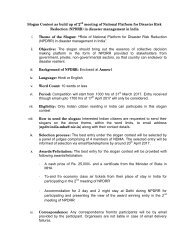National Disaster Management Guidelines School Safety Policy
School-Safety-Policy
School-Safety-Policy
Create successful ePaper yourself
Turn your PDF publications into a flip-book with our unique Google optimized e-Paper software.
SCHOOL <strong>Safety</strong><br />
POLICY <strong>Guidelines</strong><br />
All of these and any other additional ones,<br />
require the guidance and support of a panel of<br />
technical agencies to be identified at the state<br />
level and designated to work in specific districts.<br />
In this manner location specific designs can be<br />
worked out with adequate attention to safety<br />
features as well as child friendly elements.<br />
Besides these details, other design solutions<br />
in line with the Whole <strong>School</strong> Development<br />
Concept need to be incorporated to promote<br />
safety and child friendly features. Elements<br />
pertaining to school safety should be<br />
included in the whole school development<br />
approach.<br />
3.3.2 Nonstructural safety measures in<br />
schools<br />
Besides structural safety measures, non structural<br />
elements within the school campus need to be<br />
addressed to ensure safety. These are mostly low<br />
cost, regular maintenance items that the school<br />
should address on a regular basis from their own<br />
funds. Some of these items have been listed<br />
below:<br />
●<br />
●<br />
●<br />
All items of furniture such as almirahs,<br />
shelves, black boards etc., as well as any<br />
other items that may fall and cause injury<br />
to students and teachers such as ceiling<br />
fans, coolers, water tanks etc. need to be<br />
secured to the walls or floor.<br />
Any electrical items such as loose wires<br />
that may cause an exigency should be<br />
addressed promptly by the school.<br />
Chemical and any hazardous materials<br />
in the school laboratory should be<br />
handled and stored as per instructions to<br />
prevent any harm to students and school<br />
staff.<br />
● Open areas including corridors and<br />
evacuation routes including staircases and<br />
ramps should be kept free from any hurdles<br />
and barriers so that evacuation is smooth<br />
and swift.<br />
●<br />
●<br />
●<br />
●<br />
●<br />
Pots / planters in the play ground or<br />
corridors should be kept in a manner that<br />
does not affect smooth evacuation<br />
Any derelict or unused building, rubble, etc.<br />
should be removed to prevent any harmful<br />
animals or pests from accessing children.<br />
Traffic movement outside the school should<br />
be managed to minimize risk to students<br />
at the time of assembling and dispersal of<br />
school.<br />
During excursions, schools should carefully<br />
choose the location of excursion and the<br />
itinerary so that exposure to hazard is<br />
minimized. Extra precautions should be taken<br />
when students are being taken close to water<br />
bodies, narrow mountainous tracks etc.<br />
Buses or any other vehicles owned / hired by<br />
the school need to be maintained properly<br />
so that students are not at risk of accidents.<br />
Drivers need to be appropriately trained on<br />
speed limits, stoppage of vehicles as well as<br />
crisis management so that children remain<br />
safe during their travel to and from schools.<br />
● Emergency equipment such as fire<br />
extinguishers, first aid kits, ropes etc. need<br />
to be procured and maintained regularly by<br />
the <strong>School</strong> Authorities.<br />
Section 3<br />
Various Dimensions of <strong>School</strong> <strong>Safety</strong> – building on the Whole <strong>School</strong> Development Approach<br />
15



